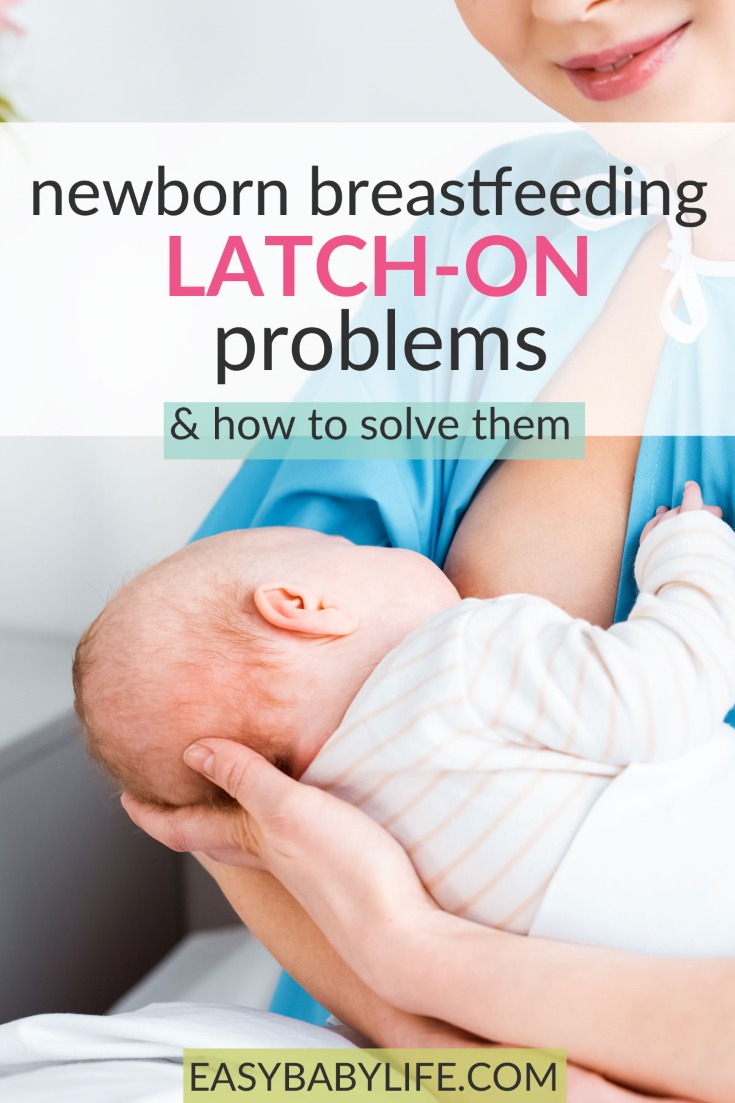It can be a really frustrating situation when you try so hard to make breastfeeding work, and your baby just won’t latch properly. Breastfeeding latch-on problems are super common, so don’t despair!
Here you’ll learn the signs of a good and poor latch, the most common reasons for latch-on problems, and how to solve them. Hang in there!

Mom’s Question:
Hi,
I have severe breastfeeding latch-on problems, and I need help!
I have a 5-day-old little newborn baby who can’t seem to latch on, and when she does, she lets go, starts to cry, and won’t do it again. So I end up pumping and feeding her with a bottle. I’ve been told it’s something you have to learn… Any help?
Angela
All About Breastfeeding Latch-On Problems and How to Solve Them
Although it is so common, a baby with breastfeeding latch-on problems can be very stressful! But please, take a deep breath and relax. Both you and your newborn are new to breastfeeding – no wonder it takes a bit of time to figure it all out!
A baby can certainly learn how to latch on properly. In fact, a lot of babies do not latch on perfectly from the start.
Is it possible for you to meet a lactation consultant where you live, for example, at the hospital? This is probably the easiest way to get rid of your breastfeeding latch-on problems quickly.
Many babies have trouble latching on in the beginning, but in most cases, a lactation consultant can help you by watching what both you and your baby do and help you identify the cause of the breastfeeding latch-on problem. A lactation consultant or midwife can usually give very helpful tips on breastfeeding positions or any other obstacles during the latching process.
13 Signs of a Good Latch
Let’s start with finding out the right signs. A good latch depends on both you and your baby. First of all, make sure that you’re holding your child in a good latching position. The most common is the cradle hold: place your baby’s head near your elbow, and use the arm to support your baby’s back.
- Align your baby’s mouth to your nipple. Make sure the neck is slightly extended and the rest of the body is in a straight, natural line across your chest.
- You’ll know that your infant latched on well if you see or feel the following:
- Your baby is faced towards your breast
- Your baby’s chin is touching your breast
- Your baby’s mouth is opened up wide with the lips turned out
- You can feel your baby’s tongue under your nipple or breast, or you can see it when you gently pull down your baby’s lower lip.
- Part of the areola (the darkened skin around the nipple) is also covered by your baby’s mouth.
- You hear your baby swallowing
- Your baby’s ears have a wiggling motion
- Your baby’s cheeks look full
- Your baby sometimes briefly pauses while sucking
- You don’t feel any nipple pain or discomfort
- Your breast feels softer after breastfeeding
How to know if your baby has a latch-on problem
If you don’t see most of the signs mentioned above, there could be a problem with latching.
Other things to watch out for are:
- Your baby keeps on latching on and off or seems to have difficulty staying latched on to you
- Your baby feeds on one breast for 30 minutes or longer or doesn’t seem satisfied after feeding
- Pain during breastfeeding (usually at the nipple area)
- Misshapen nipples after breastfeeding
- Nipples with bleeding or cracked skin
- Your baby makes a clicking or smacking sound
9 Common Reasons for Breastfeeding Latch-on Problems
A New Situation
As I just said, both you and your baby are breastfeeding beginners! This means uncertainty, stress, pain, and frustration. Your baby might be hungry, and you might be worried. No wonder you are overwhelmed!
But try to give yourself a pep talk. You can DO this! And take a deep, deep breath and do what you can to not transfer your worries to your baby. The stress itself can easily make the latch-on and the whole situation more difficult.
Try breastfeeding your baby before she is starving; more like a cozy moment. No pressure. Remember that she does take to the bottle, so she will survive! And stop before she gets frustrated. Just make eye contact, smile, express a little bit of milk, and let her try to latch on to the nipple. A calm situation will make it much easier.
Flat or inverted nipples
Sometimes mom’s nipples can be a bit hard for the baby to latch on to. If the mom has flat or inverted nipples, for example, the baby may need some extra help, like a nipple shield.
Nipples can be inverted or flat to different extents, and it can therefore be more or less challenging for the new mom to breastfeed.
The best advice I have, if you do have flat or inverted nipples, is to get professional help from a lactation consultant right from the start. Most moms with inverted nipples can breastfeed, but positioning and latch are very important to get right, and in addition to nipple shields, there may be other ways to help the situation. For example, pumping can be helpful in certain situations.
Keep in mind that the baby is supposed to latch on to the breast, not just the nipple, so even if it can be more challenging, it is certainly possible to make breastfeeding work despite having inverted nipples.
Incorrect breastfeeding position
Sometimes – actually quite often – the reason can be as easy as problems positioning your baby. Repositioning in some other way can help her latch on!
For example, if you prefer to lie down while breastfeeding, it is easy to position your baby too close to your own head. You have to put your baby so far down that he or she has to stretch their neck to reach the nipple. Otherwise, the latch-on and swallowing will be difficult for your baby. (I did this with my first baby, and thought I “couldn’t” breastfeed lying down – until a lactation consultant helped me with the next baby!)
Engorged breasts
A frequent (but easily solved) problem at the beginning of your breastfeeding experience is if your breasts are engorged.
Engorged breasts mean that they feel (and are) very full and are almost feel hard when touched. This happens when milk production starts to increase rapidly, usually a few days after delivery.
Your breasts may then be so full that it is hard for a baby to latch on and suckle when keeping up with the amount of milk flowing out. In such a case, express some milk with your hands first before breastfeeding. You can smear a little bit of milk on your nipple and offer the (now softer) breast again to your child afterward.
This way, it will be easier for her to get latch on, and the milk will start flowing immediately – but not with the same force as if your breasts are full to the brim. Simply a nicer way for your baby to start her meal. :-)
(Engorged breasts can also happen when you start to wean your baby, but that’s another story.)
Baby has a tongue tie
Tongue tie, also known as ankyloglossia, is a benign condition seen in some newborns. A thick skin or membrane connects the floor of the tongue to the bottom of the mouth, making it slightly difficult for a baby to move the tongue around. Because your baby’s tongue needs to move properly during breastfeeding, a tongue tie can make it hard to latch on.
Some tongue ties aren’t thick enough to interfere with breastfeeding and eventually go away on their own. However, when the tongue tie is thick, a healthcare provider may suggest cutting this thick skin out so your baby’s tongue can move freely. The procedure is called a tongue-tie division.
Baby is premature
Premature babies aren’t as fully developed as term babies. Some organ systems may still be immature for life outside the womb. This can include the nervous system, which controls our reflexes. A baby’s ability to drink milk depends on reflexes that control the suck-swallow-breathe actions. If these aren’t coordinated well, a baby will find it difficult to swallow or breathe while breastfeeding and end up avoiding feeding altogether.
Premature babies are usually given more urgent care and close monitoring after birth. If these feeding reflexes are not yet well coordinated, doctors may advise focusing on pumping your breastmilk and giving this to your baby in a different way – through a gastric tube or through cup feeding.
Baby has a cleft lip or palate
Some congenital conditions make it hard for breastfeeding to happen properly. In a cleft lip or palate, the tissue between the oral cavity and the nasal cavity did not completely form, leading to a passageway between the two. Babies with these conditions may end up regurgitating milk through their noses.
This is a difficult situation requiring support from a medical team. Other than possible surgery options to treat the condition, a lactation consultant or specialist should be present to help assist you with feeding your child.
Baby is sick
When babies get sick, they don’t show the usual signs and symptoms that we see in older children and adults. One way doctors assess if a baby has a possible infection or a medical condition (like congenital heart disease) is if they refuse to feed or don’t feed as much as they usually do. If you are concerned that your child may be sick, it’s best to contact your local healthcare provider or bring your child to the nearest medical center.
Down syndrome
Babies with Down syndrome often find it difficult to latch and breastfeed because of two things. First, their muscle tone isn’t as strong or steady as compared to other babies, so it makes it hard for them to suck or swallow properly or for a sustained period of time. Second, Down syndrome babies are prone to be born prematurely, which, as mentioned earlier, leads to immature reflexes for sucking, swallowing, and breathing.
Like babies with other medical conditions, seeking help from a doctor or healthcare provider is the best way to find out how to proceed with breastfeeding your baby. A lactation consultant may also help with the proper breastfeeding positions and latching.
What to Do to Mitigate the Breastfeeding Latch-on Problems
Above all, don’t give up!
Your little baby is obviously also frustrated, just like you are.
In addition to reading and following the tips above, call the hospital or your baby’s healthcare provider immediately, and don’t settle until you have an appointment within the next couple of days (preferably today!) with someone who can help you!
The longer you pump and use the bottle, the harder it will be to get your girl to breastfeed. (But it’s very good that you pump rather than just switch to formula. Now you’ll keep the supply up, and you have a great chance to get the breastfeeding to work over the week or so to come.)
A tip! To make your nipple more “tempting” for your baby, try hand-pumping just a little bit even if your breasts are not engorged, before you try to get your baby to latch on. This way, your girl will immediately get some milk when she latches on, which may be a way to reduce her frustration and impatience.
While waiting for your breastfeeding journey to kick in, skin-to-skin contact with or without breastfeeding helps calm both mom and baby, and helps them bond together. One study (see references below) even concluded that skin-to-skin contact helps relieve the baby’s stress and helps resolve latching problems much quicker.
You should know that, especially the first time, it can take several weeks for both mom and baby to learn how to get the breastfeeding to work smoothly. This can be a very tough time, with sore nipples, a sense of failure, and worrying that the baby will not get the nutrition she needs.
Support from a lactation consultant or an experienced midwife is a really good way to shorten this tough time and not have Mom simply give up.
Since your girl is only five days old, it is not strange at all that the two of you have not gotten this to work yet, but you WILL, with a little help. While waiting for your appointment, you can also check out these breastfeeding latch-on video clips to see if they might help you a bit.
You can read about more common breastfeeding problems here.
I really wish you good luck, and congratulations on your daughter!
Paula
Read Next
- Newborn Baby Doesn’t Eat Or Cry – Normal?
- How Often Should A Newborn Baby Pee?
- All about newborn babies
- My baby only sleeps when breastfeeding
- Can I give veggies to my newborn?
References
- Steps and Signs of a Good Latch | WIC Breastfeeding Support (usda.gov)Difficulty with Latching On or Sucking (stanfordchildrens.org)
- Reilly S, Reid J, Skeat J, Cahir P, Mei C, Bunik M; Academy of Breastfeeding Medicine. ABM clinical protocol #18: guidelines for breastfeeding infants with cleft lip, cleft palate, or cleft lip and palate, revised 2013. Breastfeed Med. 2013 Aug;8(4):349-53. doi: 10.1089/bfm.2013.9988. Erratum in: Breastfeed Med. 2013 Dec;8(6):519. PMID: 23886478; PMCID: PMC3725852.
- Svensson, K.E., Velandia, M.I., Matthiesen, AS.T. et al. Effects of mother-infant skin-to-skin contact on severe latch-on problems in older infants: a randomized trial. Int Breastfeed J 8, 1 (2013). https://doi.org/10.1186/1746-4358-8-1
- Add your comments below.

Paula Dennholt founded Easy Baby Life in 2006 and has been a passionate parenting and pregnancy writer since then. Her parenting approach and writing are based on studies in cognitive-behavioral models and therapy for children and her experience as a mother and stepmother. Life as a parent has convinced her of how crucial it is to put relationships before rules. She strongly believes in positive parenting and a science-based approach.
Paula cooperates with a team of pediatricians who assist in reviewing and writing articles.








I wish new mothers with inverted nipples were not constantly being told that breastfeeding is easy or ‘no big deal’. I sometimes wonder if the people who write this advice really know just how severe some inverted nipples are. For me it was impossible and the sooner health and lactation professionals acknowledge the real problems such women face, the better.
Hi Jill, and thank you for taking the time to comment! You are totally right. Breastfeeding with inverted nipples can be extremely challenging. I had to check what I had written, and I rephrased a bit thanks to your comment.
I agree with you that this is probably much more ignored than it should be. One of my best friends had a similar situation to yours, and it was a nightmare. She was in so much pain before she got proper help.
Sometimes breastfeeding is not the best choice for the baby and mom or simply doesn’t work.
Take care,
This was very helpful. I have a 5 day old son and we are going through the same thing. So it was encouraging. Thanks Paula